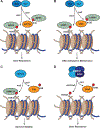Lysine Methylation Regulators Moonlighting outside the Epigenome
- PMID: 31539507
- PMCID: PMC6756181
- DOI: 10.1016/j.molcel.2019.08.026
Lysine Methylation Regulators Moonlighting outside the Epigenome
Abstract
Landmark discoveries made nearly two decades ago identified known transcriptional regulators as histone lysine methyltransferases. Since then, the field of lysine methylation signaling has been dominated by studies of how this small chemical posttranslational modification regulates gene expression and other chromatin-based processes. However, recent advances in mass-spectrometry-based proteomics have revealed that histones are just a subset of the thousands of eukaryotic proteins marked by lysine methylation. As the writers, erasers, and readers of histone lysine methylation are emerging as a promising therapeutic target class for cancer and other diseases, a key challenge for the field is to define the full spectrum of activities for these proteins. Here we summarize recent discoveries implicating non-histone lysine methylation as a major regulator of diverse cellular processes. We further discuss recent technological innovations that are enabling the expanded study of lysine methylation signaling. Collectively, these findings are shaping our understanding of the fundamental mechanisms of non-histone protein regulation through this dynamic and multi-functional posttranslational modification.
Copyright © 2019 Elsevier Inc. All rights reserved.
Figures




References
-
- Ambler RP, and Rees MW (1959). Epsilon-N-Methyl-lysine in bacterial flagellar protein. Nature 184, 56–57. - PubMed
-
- Baubec T, Colombo DF, Wirbelauer C, Schmidt J, Burger L, Krebs AR, Akalin A, and Schübeler D (2015). Genomic profiling of DNA methyltransferases reveals a role for DNMT3B in genic methylation. Nature 520, 243–247. - PubMed
-
- Biggar KK, and Li SSC (2015). Non-histone protein methylation as a regulator of cellular signalling and function. Nat. Rev. Mol. Cell Biol 16, 5–17. - PubMed
Publication types
MeSH terms
Substances
Grants and funding
LinkOut - more resources
Full Text Sources
Research Materials

